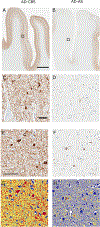Clinicopathologic subtype of Alzheimer's disease presenting as corticobasal syndrome
- PMID: 31399334
- PMCID: PMC9262170
- DOI: 10.1016/j.jalz.2019.04.011
Clinicopathologic subtype of Alzheimer's disease presenting as corticobasal syndrome
Abstract
Introduction: The corticobasal syndrome (CBS) is associated with several neuropathologic disorders, including corticobasal degeneration and Alzheimer's disease (AD).
Method: In this report, we studied 43 AD patients with CBS (AD-CBS) and compared them with 42 AD patients with typical amnestic syndrome (AD-AS), as well as 15 cases of corticobasal degeneration and CBS pathology.
Results: Unlike AD-AS, AD-CBS had prominent motor problems, including limb apraxia (90%), myoclonus (81%), and gait disorders (70%). Alien limb phenomenon was reported in 26% and cortical sensory loss in 14%. Language problems were also more frequent in AD-CBS, and memory impairment was less frequent. AD-CBS had more tau pathology in perirolandic cortices but less in superior temporal cortex than AD-AS. In addition, AD-CBS had greater neuronal loss in the substantia nigra.
Discussion: AD-CBS is a clinicopathological subtype of AD with an atypical distribution of Alzheimer-type tau pathology. Greater neuronal loss in the substantia nigra may contribute to Parkinsonism which is not a feature of typical AD.
Keywords: Alzheimer's disease; Corticobasal syndrome; Neurodegeneration; Neuropathology; Tau.
Copyright © 2019. Published by Elsevier Inc.
Conflict of interest statement
Conflict of interest statement: The authors have declared that no conflict of interest exists.
Figures



Similar articles
-
Early stage memory impairment, visual hallucinations, and myoclonus combined with temporal lobe atrophy predict Alzheimer's disease pathology in corticobasal syndrome.Neurocase. 2018 Jun;24(3):145-150. doi: 10.1080/13554794.2018.1494290. Epub 2018 Jul 10. Neurocase. 2018. PMID: 29987978
-
Alzheimer's disease and corticobasal degeneration presenting as corticobasal syndrome.Mov Disord. 2009 Jul 15;24(9):1375-9. doi: 10.1002/mds.22574. Mov Disord. 2009. PMID: 19425061
-
CSF Alzheimer's disease-like pattern in corticobasal syndrome: evidence for a distinct disorder.J Neurol Neurosurg Psychiatry. 2011 Aug;82(8):834-8. doi: 10.1136/jnnp.2010.221853. Epub 2011 Feb 22. J Neurol Neurosurg Psychiatry. 2011. PMID: 21345847
-
Neuropathology and emerging biomarkers in corticobasal syndrome.J Neurol Neurosurg Psychiatry. 2022 Jun 13;93(9):919-29. doi: 10.1136/jnnp-2021-328586. Online ahead of print. J Neurol Neurosurg Psychiatry. 2022. PMID: 35697501 Free PMC article. Review.
-
The corticobasal syndrome-Alzheimer's disease conundrum.Expert Rev Neurother. 2011 Nov;11(11):1569-78. doi: 10.1586/ern.11.153. Expert Rev Neurother. 2011. PMID: 22014136 Free PMC article. Review.
Cited by
-
Longitudinal Evolution of Posterior Cortical Atrophy: Diagnostic Delays, Overlapping Phenotypes, and Clinical Outcomes.Neurology. 2025 May 13;104(9):e213559. doi: 10.1212/WNL.0000000000213559. Epub 2025 Apr 8. Neurology. 2025. PMID: 40198862 Free PMC article.
-
The Discourse Profile in Corticobasal Syndrome: A Comprehensive Clinical and Biomarker Approach.Brain Sci. 2022 Dec 12;12(12):1705. doi: 10.3390/brainsci12121705. Brain Sci. 2022. PMID: 36552165 Free PMC article.
-
Differential Diagnosis of Rare Subtypes of Progressive Supranuclear Palsy and PSP-Like Syndromes-Infrequent Manifestations of the Most Common Form of Atypical Parkinsonism.Front Aging Neurosci. 2022 Feb 9;14:804385. doi: 10.3389/fnagi.2022.804385. eCollection 2022. Front Aging Neurosci. 2022. PMID: 35221993 Free PMC article. Review.
-
Connectome-based modelling of neurodegenerative diseases: towards precision medicine and mechanistic insight.Nat Rev Neurosci. 2023 Oct;24(10):620-639. doi: 10.1038/s41583-023-00731-8. Epub 2023 Aug 24. Nat Rev Neurosci. 2023. PMID: 37620599 Review.
-
Tau deposition patterns are associated with functional connectivity in primary tauopathies.Nat Commun. 2022 Mar 15;13(1):1362. doi: 10.1038/s41467-022-28896-3. Nat Commun. 2022. PMID: 35292638 Free PMC article.
References
-
- Dubois B, Feldman HH, Jacova C, Hampel H, Molinuevo JL, Blennow K, et al. Advancing research diagnostic criteria for Alzheimer’s disease: the IWG-2 criteria. Lancet Neurol. 2014;13:614–29. - PubMed
-
- Panegyres PK, Goh J, McCarthy M, Campbell AI. The Nature and Natural History of Posterior Cortical Atrophy Syndrome: A Variant of Early-onset Alzheimer Disease. Alzheimer Dis Assoc Disord. 2017;31:295–306. - PubMed
-
- Johnson JK, Head E, Kim R, Starr A, Cotman CW. Clinical and pathological evidence for a frontal variant of Alzheimer disease. Arch Neurol. 1999;56:1233–9. - PubMed
Publication types
MeSH terms
Substances
Grants and funding
LinkOut - more resources
Full Text Sources
Medical
Research Materials

